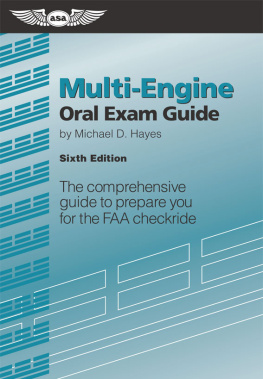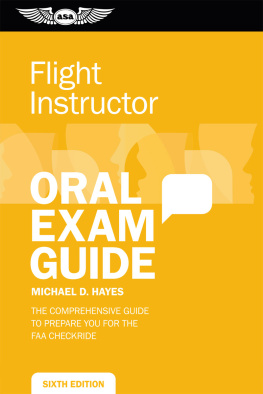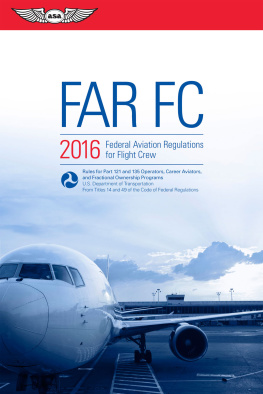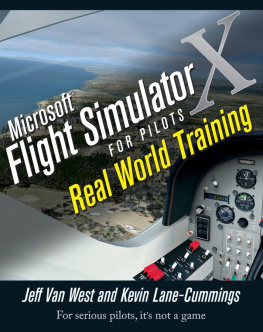
Guide to the Flight Review
Seventh Edition
by Jackie Spanitz
Aviation Supplies & Academics, Inc.
7005 132nd Place SE
Newcastle, Washington 98059-3153
Go to www.asa2fly.com/reader/oegbfr for further resources associated with this book. Also, visit the ASA website often ( www.asa2fly.com , Product Updates link or search OEG-BFR) to find updates posted there due to FAA regulation revisions that may affect this book.
19942013 Aviation Supplies & Academics, Inc.
All rights reserved. Seventh Edition published 2013. Previously published as Guide to the Biennial Flight Review.
No part of this book shall be reproduced, stored in any retrieval system, or transmitted by any means, electronic, mechanical, xerographic, audio/visual record, or otherwise, without the written permission from the publisher. While every precaution has been taken in the preparation of this book, the publisher and Jackie Spanitz assume no responsibility for errors or omissions. Neither is any liability assumed for damages resulting from the use of the information contained herein. None of the material in this guide supersedes any documents, procedures, or regulations issued by the Federal Aviation Administration.
Portions of this book were previously published in the Private Oral Exam Guide by Michael D. Hayes.
ASA-OEG-BFR7-EB
epub ISBN 978-1-61954-083-5
Kindle ISBN 978-1-61954-084-2
LC# 94-36559
Introduction
What is the Flight Review?
This guide to the flight review (previously called Biennial Flight Review or BFR) is a comprehensive guide to prepare for taking or issuing a flight review. The flight review has been an FAA requirement since 1974 and was developed to curb pilot-related accidents. Although it has accomplished this objective, there is still room for improvement. A standard flight review should offer an effective learning experience that will further reduce pilot-related accidents. The FAAs guidance document reprinted in Appendix 3 provides some excellent and very specific recommendations on how to use the flight review in this capacity.
There has been confusion about the nature of the flight review. It is not intended to be another checkride, but rather an assessment of the pilots skills, with the sole objective to determine if the pilot is safe in the operations he/she usually conducts. With this in mind, this guide will prepare and offer some guidance to those taking or issuing a flight review.
Again, the flight review is meant to determine your ability to handle the airplane safely and with good judgment. It is not meant to be like the checkride, but rather instructional. The maneuvers performed in the flight should reflect the pilots experience and type of flying; the actions should be predictable to the instructor and conform to local procedures, with safety being the main concern. The flight review should be considered an opportunity. It could be performed annually, as recurrent or refresher training, or biennially, as required by 14 CFR 61.56.
Flight Review Candidates
14 CFR 61.56 states that every pilot must take a flight review every 24 calendar months. This means every pilot must take a flight review in order to maintain pilot-in-command (PIC) privileges.
Requirements (14 CFR 61.56)
The conduct of the flight review is at the discretion of the flight instructor, but the FAA does state minimum requirements necessary for the satisfactory completion:
1 hour of flight training and 1 hour of ground training
A review of 14 CFR Part 91
A review of those maneuvers and procedures necessary for the pilot to demonstrate the safe exercise of the privileges of the pilot certificate
A logbook endorsement stating the satisfactory completion of the check
See Appendix 1 for the complete 14 CFR 61.56, and Appendix 3 for the FAAs recommendations on content and best use of time during the flight review.
Options for Completing the Flight Review
With safety in mind, the flight review can be completed in a manner beneficial to the pilot:
A flight review with a flight instructor
Everyone can use some dual flight periodically. This would be a prime opportunity to brush up on skills not frequently used. If flights normally take place at a nontowered airport, flight into a busier airport could increase proficiency in radio communications, and airspace. If straight and level is the normal attitude, some unusual attitudes and hood-work would be beneficial. If flights are normally conducted within the local area, a cross-country could be planned.
This is the suggested route to take for those that dont have the opportunity to fly as frequently as they might likework off that rust! See Appendix 3 for the FAAs recommendations on how to conduct an effective flight review.
Upgrade your pilot certificate
The FAA does not specify which aircraft a candidate must use for the flight review (however, this might change in the future). With this in mind, this would be a prime opportunity to get that instrument rating, sea rating, multi-engine rating, glider license, or helicopter license. Any checkride meets the requirements of a flight review, so the skys the limit! The FAA also states the flight review requirements can be accomplished in combination with other recency requirements: interpreted, this means candidates can become night current, instrument current, or tailwheel current (keep in mind that additional tasks will be added to meet both requirements).
This is the suggested route for those who are flying frequently, have little rust on their skills, and who are looking to expand their flying horizons. Again, safety is the main issue, and careful consideration should be taken before deciding which aircraft will be used. The NTSB suggests taking the flight review in the aircraft most frequently flown, or the most complicated aircraft for which you are rated.
The WINGS Program
A person who has satisfactorily completed one or more phases of an FAA-sponsored pilot proficiency award program (the WINGS Program) meets the requirements of a flight review. This program was developed as a way to promote proficiency and safety, while providing a motivation for pilots to do so. What pilot doesnt feel satisfaction with an earned pair of wings?
Its a great program that gives pilots the opportunity to attend FAA safety seminars, participate in online courses and be rewarded for meeting the regulatory requirements. See Appendix 4 and visit www.faasafety.gov for more information on the WINGS Program.
Conduct of the Flight Review
Although the regulation (14 CFR 61.56, see Appendix 1) does not specify which maneuvers should be included in a flight review, the FAA has provided some guidance to include suggested procedures. Ultimately the contents of a flight review are at the discretion of the flight instructor, but for a consistent and thorough check, consult AC 61-98B (see Appendix 2), and the FAAs Guidance Document: Conducting an Effective Flight Review (see Appendix 3).
The flight review should be conducted in an efficient manner, meeting the 1 hour ground and 1 hour flight requirement, without being excessive.
The following FAA documents are used as references throughout the book. Be sure to use the latest revision of each document when preparing for your flight review:
14 CFR Part 43Maintenance, preventive maintenance, rebuilding, and alteration
14 CFR Part 61Certification: Pilots, flight instructors, and ground instructors
14 CFR Part 91General operating and flight rules
Next page











